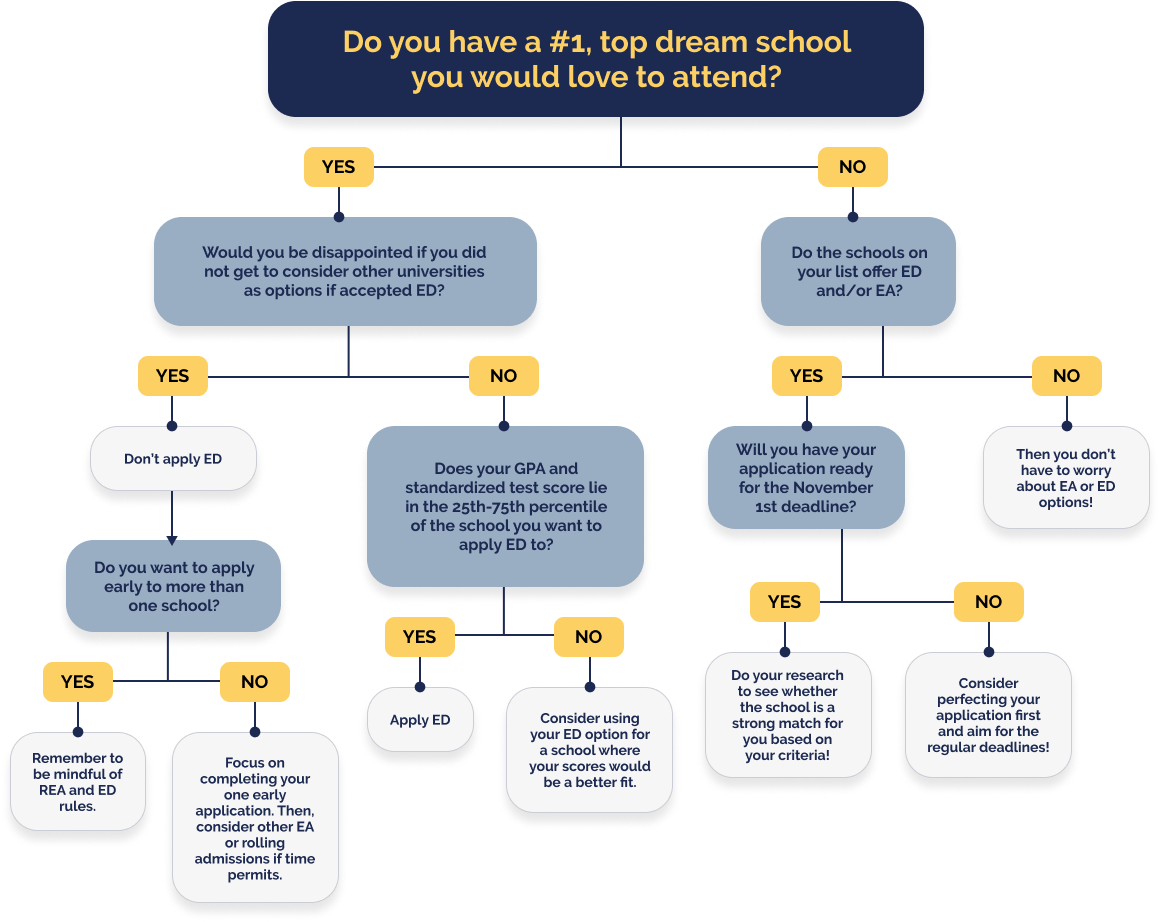What is the difference between Early Decision, Early Decision II, Early Action and Restrictive Early Action?
Applying to colleges under an Early Decision program (ED) can be both alluring and scary for prospective applicants. On one hand, applying early decision can offer an increased chance of admission and the peace of mind that comes with completing your entire college decision process by December. On the other hand, it can be frightening to commit to a binding agreement to attend a college without testing your chances at other schools.
There are four types of early admissions programs offered by colleges—here’s what each of them means for applicants:
1 Early Decision
Early Decision is binding and restrictive. Binding, as in binding commitment, means that you’ll be obligated to enroll if you are accepted, possible exceptions being medical or financial reasons. Restrictive means that you can only apply to one school. Both of these requirements make applying early decision advantageous.
2 Early Decision II (ED II)
Early Decision II has the same requirements and restrictions as Early Decision I, but occurs later in the application cycle, at the same time as the regular decision deadline, usually the first week of January.
Note: Fewer schools offer this application option, but opting to apply EDII to a school that does is a great way to demonstrate committed interest, and often, to take advantage of higher acceptance rates.
3 Early Action
Early Action (EA) is non-binding and non-restrictive. This means that you can apply to as many other EA schools as you’d like, and you are not committing to attend the school if you are accepted. EA deadlines are usually November 1st, but exceptions exist. For example, UNC Early Action applications are due on October 15th.
KEY TIP
Check the policies of the school you’re EDing to. In most cases, you can apply ED and EA to other universities at the same time. Sometimes, you’ll only be able to EA to public schools.
4 Restrictive Early Action
Restrictive Early Action, or Single Choice Early Action, is non-binding and restrictive. While you are not obligated to attend the school if accepted, you cannot apply to any other private schools early action, early decision, or restrictive early action. However, you can apply to schools with rolling admissions or public schools with EA options.
Watch the one-minute video to explore if Early Decision is right for you.
Why should I apply Early Decision?
Every school offers a different set of application options with different deadlines, so it’s important to check each school’s admissions page before making your decision.
That said, is it a good idea to apply to a school Early Decision? Let’s consider several common reasons for students to apply Early Decision.
Applying ED will give me a better chance of getting into this school.
This is probably the most common reason that ED is such a popular choice.
Applying ED is the best way to demonstrate interest in a school, and in a time when the admissions process is becoming increasingly competitive for students, schools will be glad to know that you’re certainly going to attend if they accept you.
During the last admissions cycle, Brown University admitted 896 students during early decision, yielding a 14.6% acceptance rate. Brown’s regular decision acceptance rate, on the other hand, was a record-low 5%. Additionally, many universities usually accept about half of their freshman class through early decision. This last application cycle, Dartmouth University accepted 530 students during early decision and planned for a total incoming class of 1,150 students. Of course, it’s difficult to know whether this is correlation or causation—it may be that those students who are perfect for Brown are more likely to apply early, and athletes who have been given likely letters also tend to be accepted in this round—but it stands to reason, at least, that applying ED can’t hurt.
KEY TIP
The boost you receive from early decision will vary from school to school, and will also vary, somewhat unpredictably, from year to year. That being said, many schools publish their Early Decision, Early Action, Early Decision II and Regular Decision acceptance rates on their websites. You can get a sense of the general trends by looking at each school’s published data.
I have done extensive research and am certain that this school is a strong match for me.
This is a key aspect of ED and one that should be self-evident. Do not apply early decision to a school that you would not be absolutely thrilled to attend should you be accepted. Do not apply ED to a school if you aren’t completely certain that it is your #1 choice, because you won’t be able to back out of it. Don’t apply ED anywhere if you’re not certain that your GPA and test scores will make you a strong match and give you a good chance of being accepted. It would be a shame to waste an advantageous early decision application on a school that isn’t a good match for you. This leads us to the third reason people apply ED…
This college has always been my dream school.
Trust your gut! Ultimately, you should intuitively feel strongly that this school is the right one for you. Choosing to apply to a school early decision can depend on factors beyond the technicalities: maybe this is the school you’ve dreamed of attending since you were little. Or maybe you visited the school and instantly fell in love. Or, maybe you have a close family member or friend who attended the school and you feel close ties to the institution. Whatever the reason is, make sure that the school is a cultural and social fit for you. Are you comfortable with a smaller undergraduate population with a reverence for school traditions? How important is it that your school has strong, well-attended varsity sports programs? Will you work better in a more relaxed, collaborative atmosphere or a competitive, “work hard, play hard” environment?
For more guidance to help you evaluate whether your dream school is the right fit, try taking our College List Generator and check out our College Planning Worksheet, which is part of our guide about how to Create a Balanced College List.
I understand my family’s financial situation and ED works for us.
Make sure that you understand the financial options available to you before choosing to apply to a school ED. At many schools, matriculation is contingent upon a satisfactory offer of financial aid, but if it makes financial sense for your family to weigh different aid options at different colleges, it might be best to apply to multiple schools EA instead. Regardless, make sure that you can calculate the Expected Family Contribution in as much detail as possible so that if you’re offered less than you expected, you can appeal and/or back out of the commitment.
I’m okay with the potential disappointment of not getting in—and prepared to deal with the next round of applications.
Expect the best, but prepare for the worst. This means that you should be ready for the possibility that you might not get in—not only from an emotional point of view, but logistically as well. Should you not get accepted to the school to which you applied ED, you won’t have time to start a series of other applications from scratch. So, it is extremely important that you prepare in advance by assembling applications to other schools, and be ready to submit them should you be rejected from your ED school. Make sure that you’re not scrambling to apply to the rest of the schools on your list—if you wait, chances are the quality of your application (and the likelihood of acceptance) will suffer.
The college application process is rarely simple or clear. Applying to your top school ED can somewhat simplify the process, but it can also create a whole host of potential complications and disappointments. What you end up choosing to do is a personal choice, but as with all other things, make sure that you’re prepared for all possible outcomes.
Is Early Decision or Early Action right for me?
Use our Early Admissions flow chart to determine if Early Decision or Early Action is right for you!





